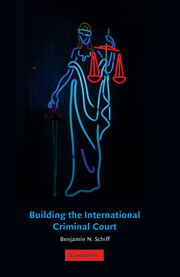Book contents
- Frontmatter
- Contents
- Preface
- Acronyms
- Building the International Criminal Court
- Introduction
- 1 River of Justice
- 2 Learning from the Yugoslavia and Rwanda Tribunals
- 3 The Statute – Justice versus Sovereignty
- 4 Building the Court
- 5 NGOs – Advocates, Assets, Critics, and Goads
- 6 ICC–State Relations
- 7 The First Situations
- 8 Conclusions: The Politics of the International Criminal Court
- Web Sites for Further and Ongoing Information
- Bibliography and Sources
- Index
4 - Building the Court
Published online by Cambridge University Press: 05 September 2012
- Frontmatter
- Contents
- Preface
- Acronyms
- Building the International Criminal Court
- Introduction
- 1 River of Justice
- 2 Learning from the Yugoslavia and Rwanda Tribunals
- 3 The Statute – Justice versus Sovereignty
- 4 Building the Court
- 5 NGOs – Advocates, Assets, Critics, and Goads
- 6 ICC–State Relations
- 7 The First Situations
- 8 Conclusions: The Politics of the International Criminal Court
- Web Sites for Further and Ongoing Information
- Bibliography and Sources
- Index
Summary
Once the Statute was opened for signature on July 17, 1998, the ICC project faced a nebulous interregnum. Pessimists thought the Statute might languish without the requisite number of adherents for five or ten years, or even perhaps indefinitely. Optimists pressed for preparations to be made to establish the Court, believing that ratifications might snowball. The optimists were prescient. The needed 60 ratifications were in hand in April 2002, less than four years after the Statute had been completed – so quickly (as compared with the pessimists' vision) that practical preparations were rushed. (development of the Court was leisurely compared to the ad hoc tribunals' rapid genesis. From the adoption of the Yugoslavia Tribunal's Statute in May 1993, 18 months elapsed until the ICTY issued its first indictment.) For the ICC, the almost four-year hiatus between the Statute's being opened for signature and coming into force allowed negotiators to complete the Rules of Procedure and Evidence, Elements of Crimes, and other vital operational documents. Another year passed before the Court had a Prosecutor in place, and he first requested arrest warrants for suspects (in Uganda) in May 2005, almost seven years from the adoption of the Statute, three years after it took effect, just short of two years after the Prosecutor took office.
The Court that started operating on July 1, 2002, has less formal power than the ad hoc tribunals, since its jurisdiction is constrained by “complementarity” while theirs had “primacy,” but it potentially has more to do, since their territorial and temporal jurisdictions were limited, but the ICC's are open-ended.
- Type
- Chapter
- Information
- Building the International Criminal Court , pp. 102 - 143Publisher: Cambridge University PressPrint publication year: 2008

